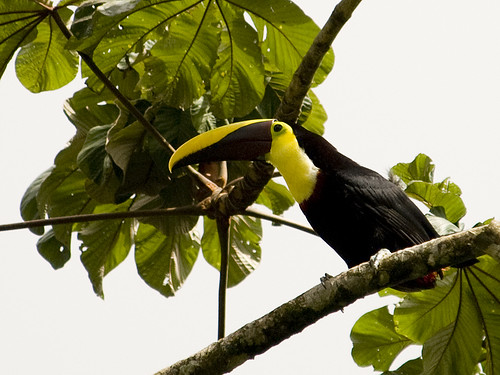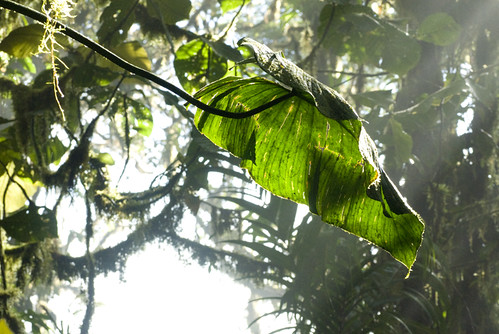A Chestnut-Mandibled Toucan... Not a King Billed Toucan, which is what Toucan Sam is.
R and I were in Costa Rica last week, so I wasn't able to wish you all a Happy Hanukkah on the first night. But here I am, finally: Home in Canada where the snow is plentiful. Our flight home was delayed by 2.5 hours and we got home at 5am on Tuesday morning. I'm sure that I'm still trying to catch up on the sleep that I missed because of this.
We pretty much only did two things in Costa Rica: We hiked and we ate. We stayed mostly inland (where it's not especially hot) and spent our time near Lake Arenal where there's an active volcano that erupts more than once a day, and in the Monteverde Cloud Forest Reserve, where there a a lot of really cool birds and animals.
There were a few things about their traditional cuisine (or, as they call it, "typical food") that I really loved, but I'll stick to the things that you could probably bring into a kosher kitchen (and if any of this is definitely NOT kosher for some reason, please comment and let me know!):
Yuca: This was my favourite. For breakfast at one of our hotels, we were served little discs that looked a lot like potato latkes. After taking a bite I got curious and asked the women in the kitchen what it was made of. Yuca! Yuca is a tuber and is used in place of potatoes in Central America because it's more readily available. We had yuca in a number of different ways, but my favourite was definitely the yuca "latkes". I'll definitely be working on a recipe for those in the weeks to come, but if anyone has one to share I'd sure appreciate it!
Heart of Palm: I'd never had it before we went to Costa Rica and it's great. The flavor is hard to describe, but the texture is firm yet smooth. It's crunchy, but not in the same way that a carrot or a piece of celery is crunchy. It's really good, but it's apparently very expensive to buy in North America. Once I have a chance to go to the Asian or Latin American market near my house I'll confirm or deny this.
Guanábana: Called Soursop in some places, guanábana is a huge fruit that is green on the outside and white with large black seeds on the inside. Because of the seeds, the flesh is difficult to eat and the fruit is usually blended with water to make a smoothie of sorts. We drank guanábana con agua just about every day that we were on vacation. It has a really unique taste and you could compare it to coconut or banana or strawberry, but it doesn't really taste like any of those things. In Costa Rica it's pretty common to find guanábana flavoured Tang in grocery stores, which I thought was really funny for some reason.
Gallo Pinto: Directly translated, gallo pinto means "spotted rooster", which is cute because that's kind of what it looks like. Gallo pinto is rice with black beans and I think that I ate more beans and rice during my stay in Costa Rica than I ever have in my life. They serve gallo pinto with almost every meal, and it made a great breakfast when we were heading out for a big hike because it's full of carbs and protein. I liked eating mine with scrambled eggs and fresh avocado. The avocado in Costa Rica is amazing because it's actually tree ripened, instead of on-your-counter-in-a-brown-bag ripened.
Poor Man's Umbrella in the Monteverde Cloud Forest Reserve.



2 comments:
where did you go to find kosher food in costa rica?
As always an excellent posting.The
way you write is awesome.Thanks. Adding more information will be more useful.
Bathmate
Post a Comment